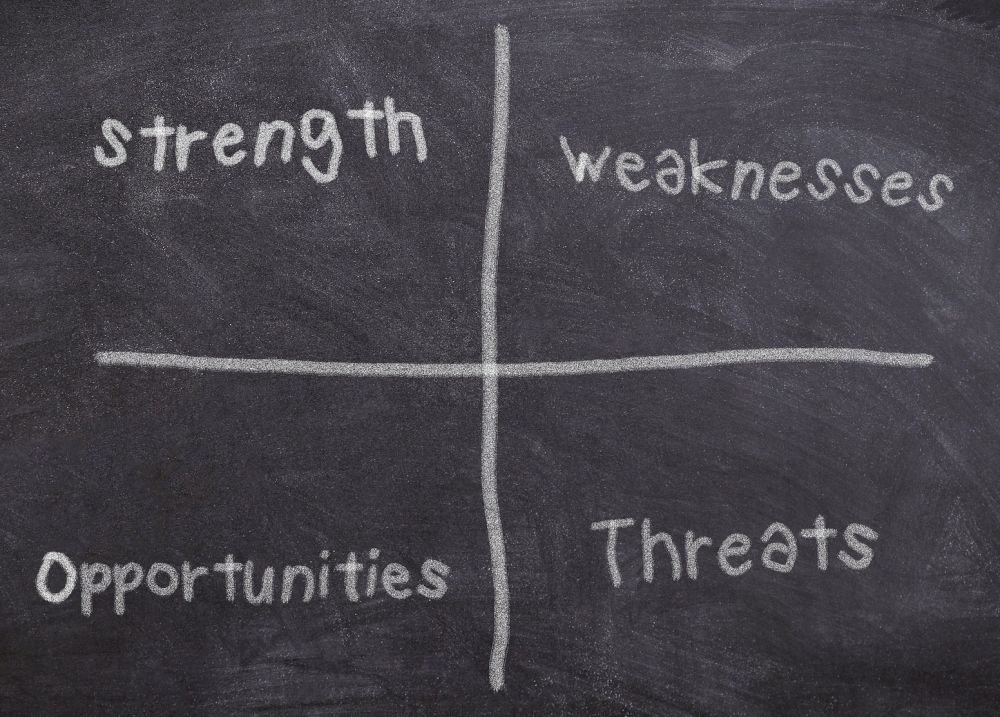6 sales forecasting techniques for marketers (+example)
Sales forecasting in marketing is a core, very important activity for most marketers. That’s because sales forecasting in marketing can […]
Read More »Become a successful marketing consultant: Learn more

A SWOT analysis is one of the most effective, simple, and essentially free management tools available.
Every owner and manager should be doing a SWOT analysis, at least once every year or two.
What is the Main Purpose of SWOT Analysis?
The purpose of a SWOT analysis is to objectively review important factors relevant to the strategic direction of your organization. A SWOT analysis can give you and your team a proper framework for making better decisions on how to prepare for potential issues and continue to drive the organization forward.
This is especially true in today’s business environment.
That’s because it's all too easy to get caught-up in the day to day, urgent activities pulling you in multiple directions. This makes it very easy to overlook the important direction of the company, and stay caught working “too deep in the weeds” of the business.
For this reason, a SWOT analysis helps you and your team to step back and objectively look at your business and stay in line with the ultimate goals and vision you have for the organization.
To view an excellent #shorts video on YouTube about your SWOT analysis, go here:

VIDEO #shorts: Purpose of a SWOT analysis
SWOT stands for Strengths, Weaknesses, Opportunities, and Threats.
Understanding each of these four components will help you build a stronger, more resilient, future focused business.
Performing a SWOT analysis is an excellent way to set a course for success, and prepare for possible roadblocks.
A SWOT analysis is a core component of a strategic plan affecting the direction of daily operations.
For most owners and managers, it’s all too easy to get extremely busy working in the business, instead of stepping back and working on the business.
Days, weeks, months and years can go by without taking a high level view of:
These are just a couple examples, but is why a SWOT analysis can be so insightful.
The deeper an owner or a manager gets immersed into their business and its daily operation, the more likely it is that important items can be overlooked.
Items that could profoundly impact the direction of the organization.
Why Do We Need SWOT Analysis?
A SWOT analysis is necessary because it allows the owner or manager the opportunity to step back and objectively review the status of the organization. A SWOT analysis empowers the management team to review the most valuable assets of the company, identify weaknesses, isolate opportunities that can impact future directions, and discuss threats facing the organization. These elements directly impact the strategic plan that is responsible for driving the direction of the company.
Let’s now dig deeper into why a SWOT analysis in marketing can be extremely valuable not just for the marketing department, but for the entire organization.
When it comes to marketing, we often think that as long as we reach as many people as possible, we're doing a great job.
Many newbie marketers focus on social shares, views, backlinks, and impressions, and forget about the most important items that really move the needle: developing marketing campaigns that make sales.
This is one of the reasons why we find the Rule of 80/20 in marketing so critically important.
With that, a SWOT analysis is absolutely a 20% activity that will contribute to producing 80% of your results. That’s because a SWOT analysis forces the team to objectively think about the most important facts facing the organization. And this activity forces the team to critically think about not just the facts, but also about important solutions.
And solutions is what marketing is all about.
In fact, gaining a customer and keeping a customer is the purpose of all business. And this is the sole purpose of marketing.
What Is the Purpose of the SWOT Analysis in Marketing?
The purpose of a SWOT analysis in marketing is to review areas that can impact gaining customers and keeping customers. Each area of a SWOT analysis is important to marketing as it can affect the marketing strategy. For example, strengths of a company impact product positioning, and a weakness in available resources affects budgeting and staffing requirements. A review of opportunities have a direct impact on identifying new market trends and isolating threats may impact how marketing communicates messages within an industry.
Let’s now look at some examples that you can pull from as you build your own SWOT analysis. And as always, if you need assistance along the way, Your Strategic Marketing Partner is happy to help.
Breaking down the examples of SWOT for your business will help you get a better idea of what an analysis can do for you and your operations plan and your marketing strategy. Here are a few examples:
Strengths
Weaknesses
Opportunities
Threats
Each business has different factors for each category. These, however, are some of the most common.
Below are several example of a SWOT analysis. Several are from a graduate level course on management from real case studies, while others are the real thing from a real small business. The purpose here is simply to give you some structure for developing your own SWOT analysis:
Harley Davidson's SWOT analysis, example:
A SWOT analysis suggests that Harley Davidson's strength is an attractive customer base in that they are a loyal base of riders, who virtually center their lives around their HOG's. A weakness is a deteriorating market of motorcycle buyers causing an uncertain landscape for internal strategic planning. A market opportunity exists for further international development as revenues have grown over 400% in the last four years. But Harley must be careful because an increasing intensity of competition from existing competitors may erode margins, posing a great threat.
| Table 1 SWOT Analysis for Harley Davidson | |
| Strengths | Weaknesses |
|
|
| Opportunities | Threats |
|
|
Similarly, here is a text paragraph example of a Starbucks SWOT analysis from a graduate level case study:
According to a SWOT analysis, Starbucks does have options. Their strength is in a huge and regular customer base, ease of customer purchase via their Starbucks card and licensing programs creating valuable brand equity while their weakness is over-saturation and the loss of being special to the consumer. Additionally, their largest opportunity is international growth possibilities while the growing competition poses their greatest threat.
Additionally, here is a text paragraph example of a Walmart’s SWOT analysis from a graduate level case study:
A SWOT analysis reveals that Wal-Mart has many strengths, leading with a reputation of low prices offering a wide array of leading brands. This strength combined with their technologies for managing the supply chain gives a distinct leadership position. Their weakness centers around a public perception that they treat their employees poorly, indicative of labor costs that were 20% less than unionized super-markets. Although this weakness does present opportunities to reinvent themselves publicly and lift up their employees. Lastly, threats come from technology changes affecting their supply chain as well as the constant threat from both competitors and suppliers.
Additionally, here is a Nucor SWOT analysis from a graduate level case study:
| Nucor SWOT analysis | |
| Strengths
| Weaknesses
|
| Opportunities
| Threats
|
Nucor has a huge distinctive competency that gives them an edge over the competition. Their organizational architecture, including their corporate culture, which is fantastic. From ethics, to environment, to team building to how the employees are treated and compensated, all this in aggregate combines to create a world-class organization that enhances the brand, build loyalty and further creates barriers to entry and a sustained competitive advantage.
Regardless of the industry a company is competing in, this alone can create a sustained competitive advantage. Indicative of winning awards and certifications as well as the team developing an early warning technology to protect the environment with the intent to license. And being a nonunion environment that focuses on teambuilding and high performance, it looks like US steel, among others, are eager to mimic. This competency provides a barrier to imitation and a sustained competitive advantage, making it very difficult for competitor to duplicate.
Small Company SWOT Analysis Example
| Strengths
| Weaknesses
|
| Opportunities
| Threats
|
SWOT Analysis is an analytical tool used to assess an organization’s Strengths, Weaknesses, Opportunities, and Threats.
Strengths refer to the internal advantages an organization has, such as its resources and capabilities.
Weaknesses refer to the internal disadvantages an organization has, such as the lack of certain resources or capabilities.
Opportunities refer to external factors that may be beneficial to an organization, such as market trends, new technologies, and customer demands.
Threats refer to external factors that may be detrimental to an organization, such as competition, regulations, and economic conditions.
SWOT Analysis is used to make decisions by helping organizations identify and assess the risks and rewards associated with potential actions.
By examining the strengths, weaknesses, opportunities, and threats associated with a particular decision, organizations can gain a better understanding of the potential consequences of their actions and make more informed decisions.
Additionally, SWOT Analysis is often used to identify gaps in an organization’s resources or capabilities and to help create strategies that can address those gaps.
SWOT Analysis is best suited for scenarios in which organizations need to make strategic decisions and identify potential risks and rewards associated with those decisions.
This includes decisions related to marketing, product development, operations, and other areas of business.
SWOT Analysis can also be used to assess a particular strategy or plan, identify areas of improvement, and develop new strategies.
Additionally, SWOT Analysis can be used to evaluate the competitive landscape and identify potential opportunities or threats.
Performing a SWOT analysis will help you get the answers you need to create the best possible strategic plan and marketing plan for your business. Go over your SWOT analysis on a regular basis and document any changes you see over time.
References